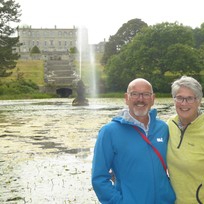( Overview
/ Two Bullocks on a Boat in Eire
After our swim we had more visitors. Julia and Alistair with their crew came in on their Southerly 105, Gigha, last night. Of course, as fellow Southerly owners we’re always keen to meet and swap stories, and they came aboard to look around Avalon.
A little later than planned, we walked into town, and passing the fish harbour saw lobsters being unloaded and weighed. We haven’t seen crab or lobster on the menu here, but all those pots we try to avoid must be producing something!
A bridge goes over a dry moat to the gate of Charles’ Fort. Unless there is running water to stop the moat stagnating and smelling bad, a dry moat was always built.
A refreshing cup of tea after the 6 mile walk, as recommended by a local resident we met in Summer Cove.
Karen was a great guide, telling us about the castle architecture, as well as Irish and social history.
Charles’ Fort was a ‘second generation’ bastion fort built in 1682. The outer wall was built in a star fashion, and in between that and a thinner inner wall, there is a wide earth section to take the impact of cannonballs. The buildings were built away from the wall to prevent damp.
The governor had his own separate area guarded by a sentry. He also had his own sally port so he could go into the moat and enter the castle by another sally port to check the troops.
The ammunition store was built without any metal nails and with a copper door and locks, which would absorb sparks. Before entering the store, men would change from wool clothing, which can create static electricity, to linen and swap their hobnail boots for wooden clogs (in the small separate hut).
A ‘blast wall’ was built to protect nearby buildings if there was an accidental explosion. The roof-like structure on top was designed to make the wall look like a building and detract from it being a target.
The White Lady. Legend has it that Wilful, the daughter of the governor, was walking on the battlements with her newly wed husband, Sir Trevor, when she admired some flowers on the rocks below. Whilst the guard was sent to pick the flowers Sir Trevor agreed to keep sentry. He fell asleep, however.
When the Governor found the ‘sentry’ asleep on duty, he drew his pistol and shot him dead. On discovering this, Wilful, still wearing her wedding dress, flung herself off the battlements in despair.
I wonder why Trevor didn’t have better things to do than act as a sentry on his wedding night?
Thinking the threat would come from the sea by the Spanish and French, the landward defences were never completed. This weakness meant it finally fell, after a 13 day siege of 50 cannonballs an hour, to the Danish and Irish during the Williamite Wars of 1690.
An early lighthouse was established here in the 17th century by Robert Reading, but this was built in 1929, and electrified in 2004.
The fort was a British Army barracks for 200 years, during which time ablution blocks were built, and housing conditions improved. The water from the wells in the grounds was brackish so water was steam-pumped down from the hills and stored in 3 tanks by the gate.
British forces relinquished the fort following the Anglo-Irish treaty of 1921 and it fell out of use after being burned by retreating anti-Treaty forces during the Irish Civil War in 1922. The parade grounds were used as a campsite, however, by hippies from 1969-73.
Kinsale Boatyard in the distance.































 Sign in with Apple
Sign in with Apple  Log in with Facebook
Log in with Facebook